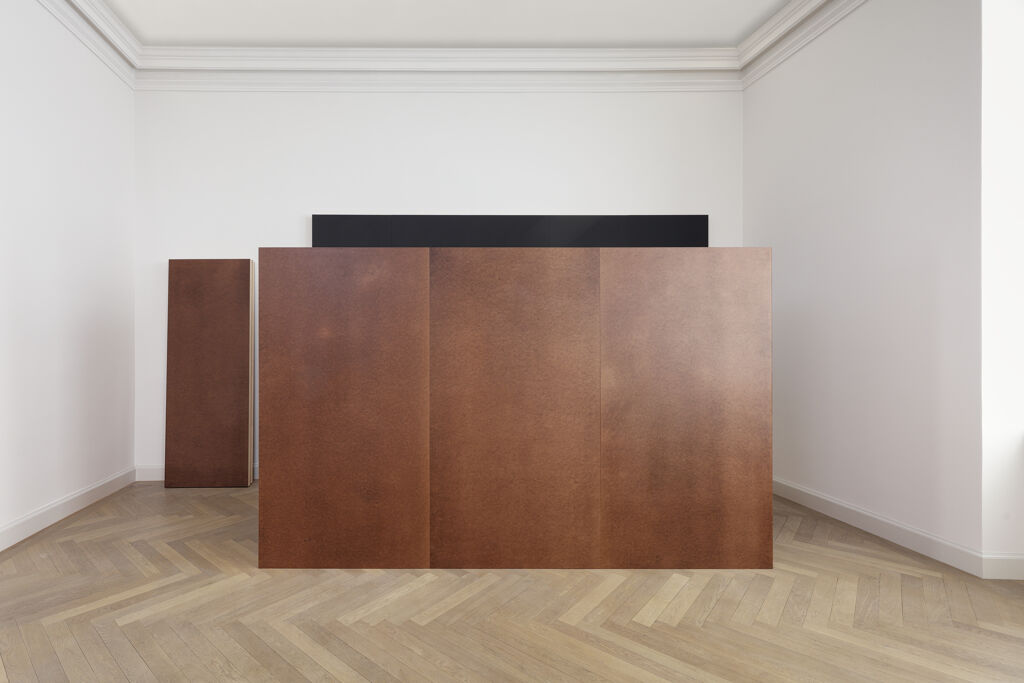Fascinated by Kasimir Malevich’s Suprematist manifestos ever since his early years of study, Knoebel had pursued the Russian artist’s investigation of figure and ground and transferred this principle of painting into a spatial context. At the beginning of his own artistic production, the programmatic sobriety in the oeuvre of the Beuys pupil became particularly clear in the radical minimization of his painterly means and in the utilization of industrially manufactured fiberboard panels. In Knoebel’s fiberboard pictures, which often consist of several combined panels, the intrinsic grain patterning of fiberboard is elevated to the status of painting. For a long time, its warm brown tone was, in addition to black and white, the only color which Knoebel allowed to appear in his works.
Each of Knoebel’s “Schattenräume” consists of a large-format, closed cube made of fiberboard and positioned directly in front of a similarly-proportioned black picture. The ensemble becomes a three-dimensional picture, carpentered out of wood and fiberboard, in which surface and space enter into dialogue with each other. “Schattenraum 6” is distinguished from its predecessors not only by its additional, exhortatory title; it is also accompanied by three large pictures done in fiberboard and acrylic (1989), which lead in the exhibition to other “Hartfaserbilder” (“Fiberboard Pictures”) such as “Hartfaserquadrat (Ehre an Kasimir Severinowitsch Malewitsch)” (“Fiberboard Square (Salute to Kasimir Severinovich Malevich)”, 1991). But above all through the addition of two fiberboard panels stacked and leaning against the wall, “Schattenraum 6” is reminiscent of Knoebel’s variably conceived spatial picture “Raum 19” (“Room 19”, 1968) in which, already during his time at the Art Academy in Düsseldorf, he laid the foundation for extensive aspects of his later creative output. And the “Keilrahmen” (“Stretcher Frame”, 1968/1989), of iconic significance for Knoebel’s stringent search for the abstract picture, arises from the formal vocabulary of his famous key work in fiberboard.
Further works from the years 1968 to 2004 are featured in the exhibition and illustrate the genesis of Knoebel’s idea of the picture. Of fundamental importance for this concept are light-based works such as “Projektion” (“Projection”, 1968). Introducing the exhibition, this work stands emblematically for the phase at the beginning of Knoebel’s artistic production when, in accordance with Malevich, he sought the greatest possible reduction of his artistic means and the immateriality of the work of art. Here with the light of a slide projector, nothing more or less than a rectangular surface is projected. “Weiße Konstellation” (“White Constellation”, 1975/1987) likewise stands in relation to Knoebel’s work with light. Four trapezoidal, white-painted wooden panels in an upwardly striving arrangement are reminiscent of forms of light shining through lattice windows onto a wall. White pictures such as this one have their source in Knoebel’s “Innenprojektionen” (“Interior Projections”), in which light from a slide projector is shined onto objects in the surrounding space, giving rise to distorted surfaces which the artist then photographed. For the forty-minute video work “Projektion X” (“Projection X”), produced in 1972 for Gerry Schum’s Television Gallery, Knoebel drove through Darmstadt by night with a light projector. The walls of buildings throughout the city became the pictorial ground for a gigantic, projected ”X” which constantly alters and distorts its shape as the automobile passes by.
“Figur 17” (“Figure 17”, 1985) is part of a series in which Knoebel applies variously-colored rectangles in acrylic onto a white ground upon wood in a further point of connection to Kasimir Malevich’s investigation of figure and ground. After a pursuit of his strictly purist line lasting many years, a collage from the context of the “Messerschnitte” (“Knife Incisions”, 1977), in which Knoebel combines color and free forms for the first time, constitutes a veritable upheaval in Knoebel’s oeuvre. In “Sandwich 2004–10” (2004), Knoebel returns to the principle of stacking which he had already developed in “Raum 19”. The picture consists of several fiberboards between which the applied layers of paint remain hidden to the viewer and appear only at the edges. All that can be seen on the surface is the grain pattern of the wood.
